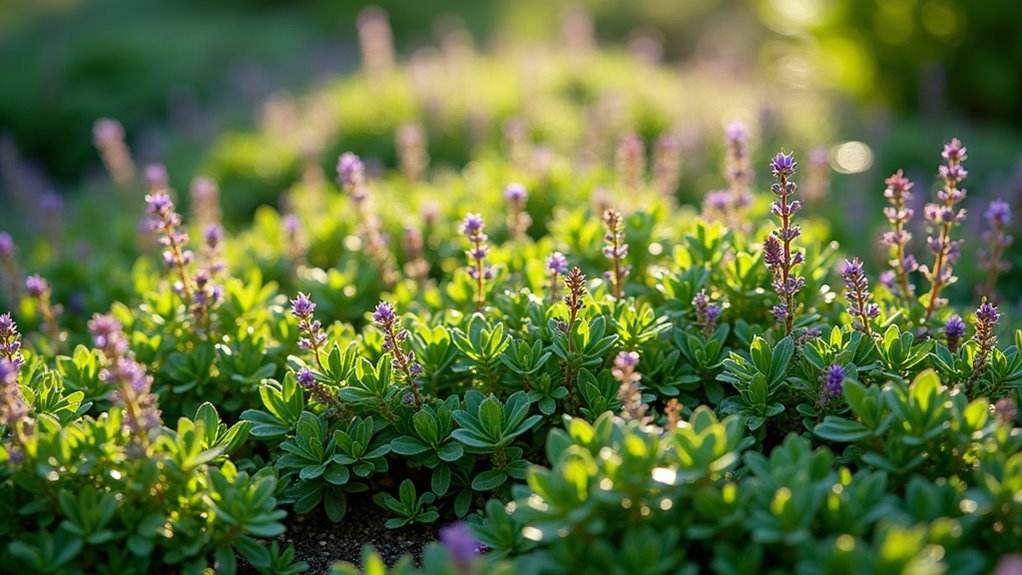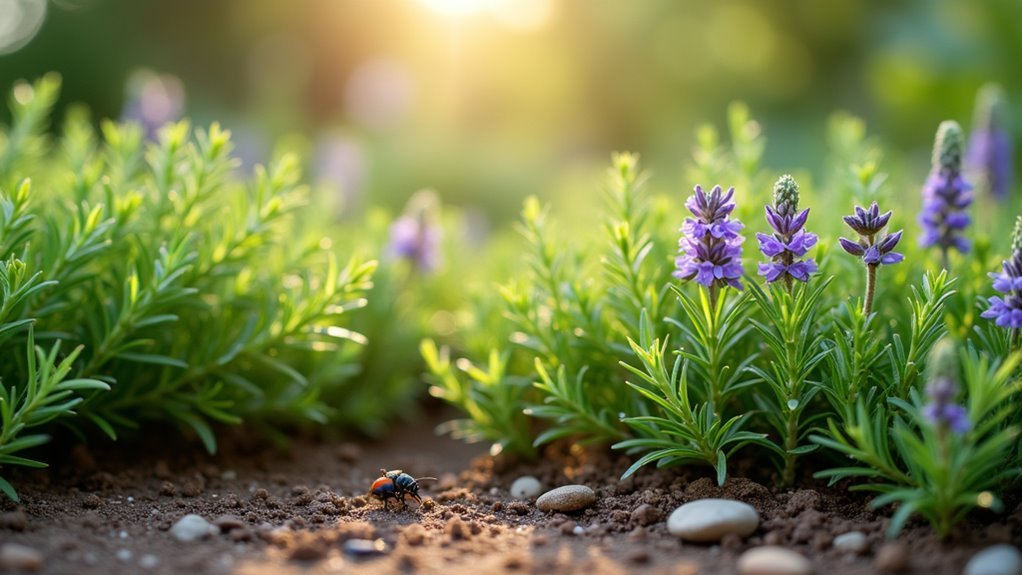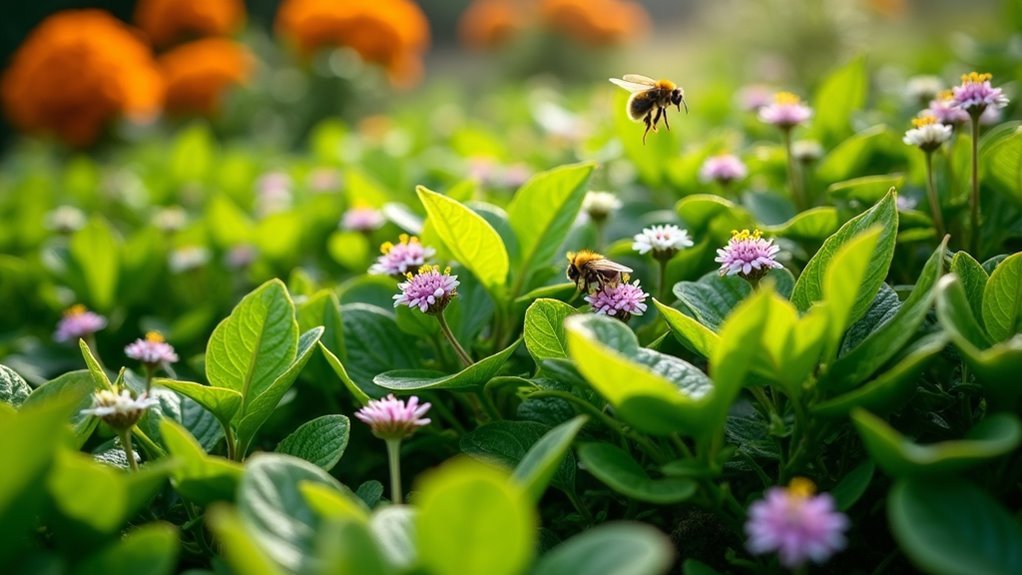You can naturally repel garden pests by choosing strategic groundcover plants that release protective compounds and scents. Marigolds produce thiophene to deter nematodes and aphids, while lavender and thyme varieties repel moths and flies through aromatic oils. Nasturtiums work as trap crops, luring pests away from valuable plants, and chrysanthemums contain natural pyrethrin for broad pest control. These low-growing defenders create protective barriers while attracting beneficial insects that enhance your garden’s natural ecosystem balance.
Benefits of Using Groundcover Plants for Natural Pest Control

While chemical pesticides remain the go-to solution for many gardeners, groundcover plants offer a natural and sustainable alternative that transforms your garden into a self-regulating ecosystem.
These low-growing plants naturally repel pests through their insecticidal properties and strong scents that deter harmful insects like mosquitoes and aphids.
Low-growing groundcover plants serve as natural pest deterrents, using their aromatic compounds to repel mosquitoes, aphids, and other garden invaders.
Your ground cover selections, such as creeping thyme, rosemary, catmint, and lavender, create protective barriers around vulnerable plants while attracting beneficial insects that enhance pollination and boost vegetable yields.
Beyond pest management, these plants maintain soil moisture and prevent erosion, strengthening overall plant health and resilience.
When you implement natural pest control through groundcover strategies alongside companion planting, you’ll create synergistic effects that reduce pest populations while promoting garden biodiversity.
Marigolds: Vibrant Blooms That Create Protective Barriers
You’ll find marigolds release thiophene, a natural compound that effectively repels nematodes, aphids, and mosquitoes from your garden beds.
These vibrant flowers work exceptionally well as companion plants alongside tomatoes and peppers, boosting their growth while providing essential pest protection.
Plant them strategically around your garden’s perimeter to create an effective barrier that reduces your reliance on chemical pesticides.
Natural Thiophene Compound Benefits
When marigolds release thiophene, a powerful natural compound, they create an invisible shield that deters nematodes and various garden pests from invading your growing space. This natural pest control mechanism works continuously as your marigolds grow, providing 24/7 protection without harmful chemicals.
The thiophene compound specifically targets soil-dwelling nematodes that damage plant roots, while the vibrant blooms effectively repel aphids and mosquitoes above ground.
You’ll notice that marigolds simultaneously attract beneficial insects like ladybugs and parasitic wasps, which further enhance your garden’s pest management system.
When you plant these versatile flowers alongside tomatoes and peppers, you’re creating a balanced ecosystem that naturally maintains pest populations while improving your vegetable yields through this dual-action approach.
Ideal Companion Plant Partnerships
Marigolds form strategic alliances with specific vegetable crops, creating powerful partnerships that maximize both pest protection and garden productivity.
These companion plants excel at establishing protective zones around vulnerable vegetables while attracting beneficial insects that enhance natural pest control systems.
When you strategically position marigolds throughout your garden, you’ll create multiple defense layers that repel pests effectively:
- Tomato partnerships – Marigolds guard against hornworms and whiteflies while boosting tomato growth
- Pepper alliances – Protection from aphids and spider mites enhances pepper yields considerably
- Perimeter plantings – Border installations attract predatory insects that eliminate harmful pests naturally
- Trap crop strategies – Marigolds divert pest attention from main crops, reducing chemical intervention needs
You’ll discover that these vibrant flowers transform your garden into a self-sustaining ecosystem where natural pest control thrives.
Effective Pest Barrier Placement
Strategic placement makes all the difference when establishing marigolds as effective pest barriers throughout your garden space. You’ll achieve ideal pest protection by positioning these vibrant flowers along vegetable bed perimeters, where they’ll intercept harmful insects before they reach your crops.
Focus your planting efforts around vulnerable plants like tomatoes and peppers, creating natural fortress walls that release thiophene compounds continuously.
Consider companion planting marigolds at garden entry points where pests typically infiltrate. Space them every 12-18 inches for maximum coverage, ensuring no gaps in your protective barrier.
You can also establish clusters near compost areas and water sources where insects congregate. This strategic approach transforms your thriving garden into a naturally fortified sanctuary that reduces pesticide dependency while maintaining beautiful aesthetics.
Lavender: Aromatic Defense Against Flying Insects
You’ll find lavender’s fragrant oils naturally repel moths, fleas, and flies while attracting beneficial pollinators like bees and butterflies.
Plant this low-maintenance herb near entrances, walkways, and garden borders where its strong scent creates an effective barrier against flying pests.
Choose sunny, well-drained spots for ideal growth, and you’ll enjoy both aromatic benefits and reduced need for chemical pest control.
Natural Moth Deterrent Properties
Among nature’s most effective flying insect deterrents, lavender stands out as a powerhouse that repels moths through its potent aromatic oils. This natural deterrent doesn’t just target moths—it’s equally effective against fleas and flies, making it an exceptional pest repellent for thorough garden protection.
You’ll maximize lavender’s moth-deterring potential by implementing these strategic approaches:
- Plant lavender in sunny, well-drained areas near entrances and walkways for ideal protection.
- Position clusters around vulnerable plants to create protective barriers.
- Harvest and dry flowers to extend deterrent benefits indoors.
- Companion plant with other aromatic herbs for enhanced effectiveness.
Lavender’s drought-tolerant nature means you’ll enjoy low-maintenance pest control while enhancing your garden’s visual appeal and fragrance simultaneously.
Strategic Placement Tips
Understanding lavender’s natural repelling power leads directly to maximizing its effectiveness through thoughtful garden positioning.
You’ll want to plant lavender near entrances, walkways, and outdoor seating areas where its strong scent creates an immediate barrier against flying pests. Position clusters around your vegetable garden’s perimeter to mask crop scents that typically draw unwanted insects.
Choose sunny, well-drained spots where lavender naturally thrives while serving as a natural insecticide. You can integrate it into mixed borders where it’ll attract beneficial insects like bees and butterflies while deterring moths, fleas, and flies.
Space plants strategically along pathways to release fragrant oils when brushed against. This dual-purpose approach guarantees you’re protecting vulnerable areas while creating aromatic, low-maintenance zones that work continuously throughout the growing season.
Thyme Varieties: Low-Growing Heroes for Small Garden Spaces

When space is at a premium in your garden, thyme varieties offer an unbeatable combination of pest control and practicality.
These low-growing perennials excel in small garden spaces while naturally deterring unwanted insects through their potent compounds thymol and carvacrol.
You’ll find these thyme varieties particularly effective for compact gardens:
- Creeping thyme – Forms dense mats that repel weevils and mosquitoes
- Wooly thyme – Provides soft, silvery ground cover with strong pest-deterrent properties
- Caraway thyme – Offers unique fragrance while maintaining excellent insect-repelling abilities
- Common thyme – Delivers reliable pest control with culinary versatility
These drought-tolerant herbs thrive in full sun and well-draining soil, requiring minimal maintenance.
They’ll spread naturally to create protective ground cover while attracting beneficial pollinators, ensuring your garden stays both pest-free and productive.
Nasturtiums: Edible Trap Crops That Lure Pests Away
You’ll find nasturtiums work differently than typical pest repellents—they actually attract aphids and caterpillars away from your valuable crops like tomatoes and cucumbers.
These vibrant flowers aren’t just effective trap crops; they’re completely edible and add a spicy, peppery kick to your salads and dishes.
Plant them strategically alongside beans, radishes, and squash to create a natural pest management system that protects your main harvest while providing fresh culinary ingredients.
Trap Crop Mechanism
Since nasturtiums produce vibrant blooms and peppery foliage that naturally attract destructive insects, they function as living decoys in your garden’s pest management system.
This trap crop mechanism works by positioning nasturtiums strategically around your vegetable beds to draw pests away from valuable crops like tomatoes, cucumbers, and radishes. The strong attraction these plants create redirects harmful insects to sacrifice plants rather than your harvest.
Here’s how nasturtiums help protect your garden:
- Natural lure – Vibrant flowers and peppery leaves entice aphids and caterpillars
- Strategic placement – Interplanting creates protective barriers around vulnerable vegetables
- Chemical-free solution – Reduces pesticide dependency through biological pest control
- Dual purpose – Edible flowers provide culinary benefits while managing pests
This approach will improve overall garden health while enhancing biodiversity throughout your growing space.
Edible Flower Benefits
Beyond their pest-control capabilities, nasturtiums offer remarkable culinary value that transforms these hardworking trap crops into gourmet ingredients for your kitchen.
You’ll discover that both flowers and leaves deliver a distinctive peppery flavor that elevates salads and various dishes with their unique taste profile. These edible flower benefits extend far beyond simple nutrition, creating a dual-purpose plant that serves your garden and dining table simultaneously.
When you plant nasturtiums alongside tomatoes, cucumbers, and radishes, you’re establishing natural pest barriers while cultivating fresh ingredients.
Their vibrant blooms attract pollinators and beneficial insects that help control harmful pest populations naturally. This low-maintenance approach means you’ll enjoy beautiful flowers, flavorful garnishes, and effective pest management without intensive gardening efforts, making nasturtiums an invaluable addition to any productive garden space.
Companion Planting Strategy
When strategically positioned throughout your vegetable garden, nasturtiums function as living decoys that draw destructive pests away from your prized crops.
These remarkable plants excel at companion planting by sacrificing themselves to protect your tomatoes, cucumbers, and radishes from aphids and caterpillars.
Your pest control strategy becomes more effective when you:
- Interplant nasturtiums as natural barriers around vulnerable vegetables
- Take advantage of their ability to thrive in poor soil without nutrient competition
- Utilize their vibrant blooms to attract beneficial insects and pollinators
- Reduce chemical pesticide dependency through natural pest management
The beauty of nasturtiums lies in their multifunctional nature.
While they’re busy luring pests away from your valuable crops, they’re simultaneously attracting predatory bugs that’ll help control pest populations throughout your garden.
Sweet Alyssum: Delicate Flowers That Attract Beneficial Predators
While most gardeners focus on plants that directly repel pests, Sweet Alyssum (Lobularia maritima) takes a different approach by attracting the good guys to your garden. This low-maintenance groundcover produces delicate white and purple flowers that draw beneficial insects like hoverflies, which feast on aphids and other garden pests.
You’ll appreciate how sweet alyssum thrives in full sun to partial shade with well-drained soil, adapting to various garden conditions. It blooms continuously from spring to frost, providing consistent food sources for beneficial insects throughout the growing season.
As an effective groundcover, it suppresses weeds while enhancing your garden’s beauty with its sweet fragrance. This natural pest control strategy creates a balanced ecosystem where predatory insects manage harmful pest populations effectively.
Creeping Rosemary: Fragrant Perennial Protection

Creeping rosemary (Salvia rosmarinus var. prostratus) offers a more direct approach to pest control through its natural insecticidal compounds. This fragrant perennial spreads wide across your garden, creating effective ground cover while actively working to repel pests through compounds like α-Pinene and 1,8-cineole.
You’ll find this versatile plant particularly effective against:
- Certain beetles that damage garden plants
- Mosquito larvae in nearby water sources
- Various insects deterred by its strong fragrance
- Fungal issues like powdery mildew when properly pruned
Plant creeping rosemary in full sun with well-draining soil for ideal pest-repelling qualities. Regular pruning encourages bushier growth and improves air circulation.
Beyond protection, you’ll appreciate its culinary purposes, adding distinctive flavor to your cooking while maintaining garden defense.
Mint Species: Containing Aggressive Spreaders for Maximum Impact
Although mint species like peppermint (Mentha × piperita) and spearmint (Mentha spicata) deliver powerful pest-repelling properties through their potent aromatic oils, you’ll need to manage their aggressive spreading habits to harness their full potential.
These aromatic powerhouses effectively deter common garden pests including ants and mosquitoes through compounds like menthol and limonene.
You’ll appreciate mint’s adaptability to various conditions—it thrives in full sun to partial shade with well-drained soil.
However, these aggressive spreaders use underground rhizomes to quickly colonize large areas, potentially overtaking neighboring plants.
To maximize their pest-repelling benefits while maintaining control, plant mint species in containers or designated garden sections.
This containment strategy lets you enjoy their protective properties and culinary uses without sacrificing your garden’s balance.
Chrysanthemums: Natural Pyrethrin Producers for Garden Perimeters
When you’re seeking a natural defense system for your garden’s perimeter, chrysanthemums deliver one of nature’s most effective insecticides—pyrethrin—right from their vibrant blooms. This natural insecticide targets roaches, ants, ticks, fleas, and silverfish, creating a protective barrier around your cultivated areas.
Strategic placement around garden borders maximizes their pest-deterrent properties:
- Plant in full sun locations with well-drained soil for ideal pyrethrin production
- Space evenly around vegetable gardens and flower beds to create continuous protection
- Choose vibrant varieties that enhance garden aesthetics while serving dual purposes
- Integrate with existing landscaping to reduce chemical pesticide dependence
You’ll find chrysanthemums require minimal maintenance while providing ornamental value and promoting healthier ecosystems. Their ability to repel pests naturally makes them invaluable additions to any garden design.
Choosing the Right Groundcover for Your Climate and Soil
Beyond selecting pest-repelling varieties like chrysanthemums, you’ll need groundcover plants that can actually survive and flourish in your specific growing conditions.
Start by evaluating your climate zone—creeping thyme thrives in warmer regions while wild geranium prefers shadier spots.
Next, assess your soil conditions carefully. Choose drought-tolerant species like creeping rosemary for well-drained soils, but avoid heavy clay that retains moisture.
Prioritize native groundcovers since they’re naturally adapted to your local environment and support pollinator populations.
Research the pest-repelling properties of candidates like catmint and lavender to target specific pests in your area.
However, avoid invasive varieties like mint and creeping Charlie that’ll quickly dominate your garden space.
Planting Strategies for Maximum Pest Deterrent Coverage
Since you’ve selected the right pest-repelling groundcovers for your conditions, strategic placement becomes essential for creating an effective defensive network throughout your garden.
Strategic placement of pest-repelling groundcovers creates a powerful defensive network that protects your entire garden naturally and effectively.
Create maximum coverage by implementing these proven strategies:
- Border Protection – Plant marigolds and nasturtiums around vegetable bed edges as companion plants that attract beneficial insects while trapping harmful pests.
- Layered Defense – Mix low-growing aromatic herbs like creeping thyme with taller crops, ensuring ideal sunlight while maximizing pest-repelling effects.
- Strategic Spacing – Position groundcover plants to form continuous barriers that release natural compounds against ants, mosquitoes, and weevils.
- Annual Rotation – Rotate plantings yearly to disrupt pest cycles and maintain soil health.
Regular pruning prevents invasiveness while maintaining effectiveness.
This systematic approach transforms your garden into a naturally protected ecosystem where pest deterrence works harmoniously with plant growth.
Frequently Asked Questions
What Plants Keep Pests Out of the Garden?
You’ll find marigolds, lavender, basil, chrysanthemums, and garlic effectively repel various garden pests. They’ll naturally deter insects like aphids, mosquitoes, flies, and ants while protecting your vegetables without using harmful chemicals.
What Plant Works as a Natural Pest Control?
You’ll find marigolds work exceptionally well as natural pest control. They release thiophene, which repels nematodes, aphids, and mosquitoes. Plant them near tomatoes and peppers for effective protection.
What Is the Best Deterrent for Garden Pests?
You’ll find integrated pest management works best, combining beneficial insects, companion planting, crop rotation, and organic sprays. Don’t rely on single methods—diversified approaches create stronger defenses against various pests throughout growing seasons.
Does Creeping Thyme Repel Pests?
Yes, you’ll find creeping thyme effectively repels garden pests. It contains thymol and carvacrol, which are toxic to weevils and bed bugs while deterring ants from invading your garden space naturally.
In Summary
You’ve discovered powerful allies in your fight against garden pests. These groundcover plants won’t just beautify your landscape—they’ll actively protect it. Start small by choosing varieties that match your climate and soil conditions. Plant them strategically around vulnerable areas, and you’ll create natural barriers that keep harmful insects at bay. Your garden will thrive with these living pest deterrents working around the clock for you.





Leave a Reply